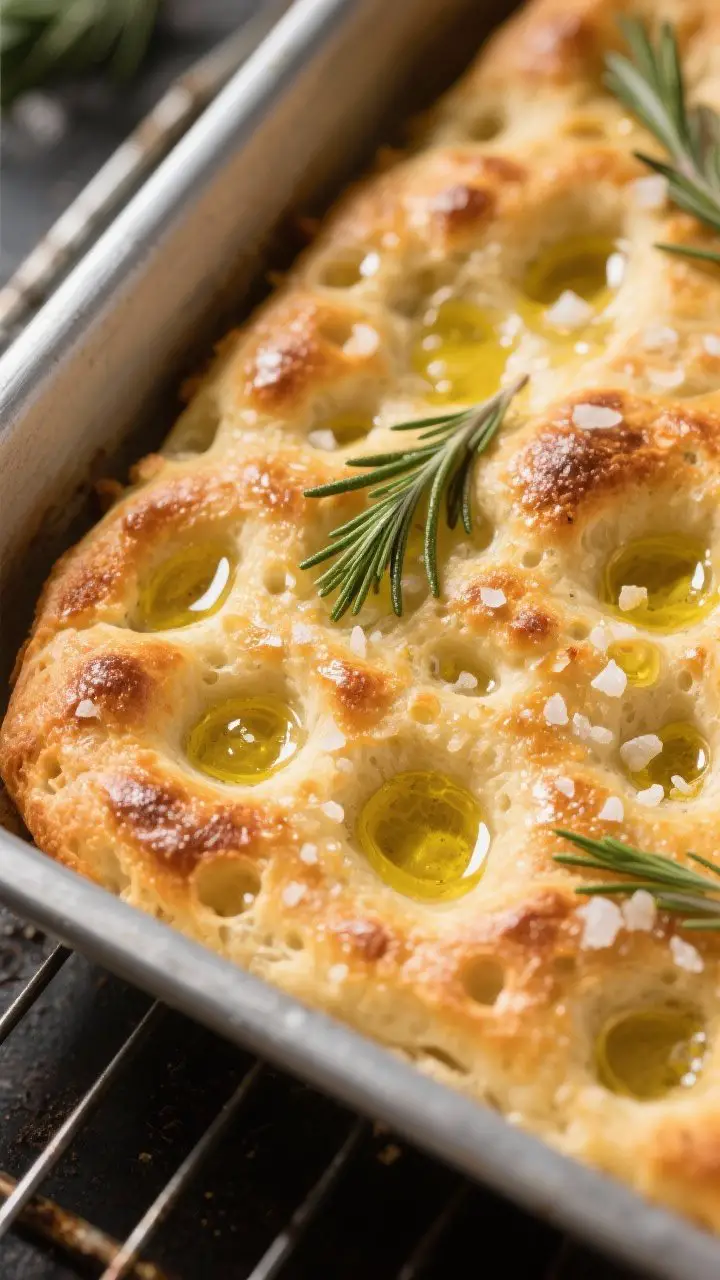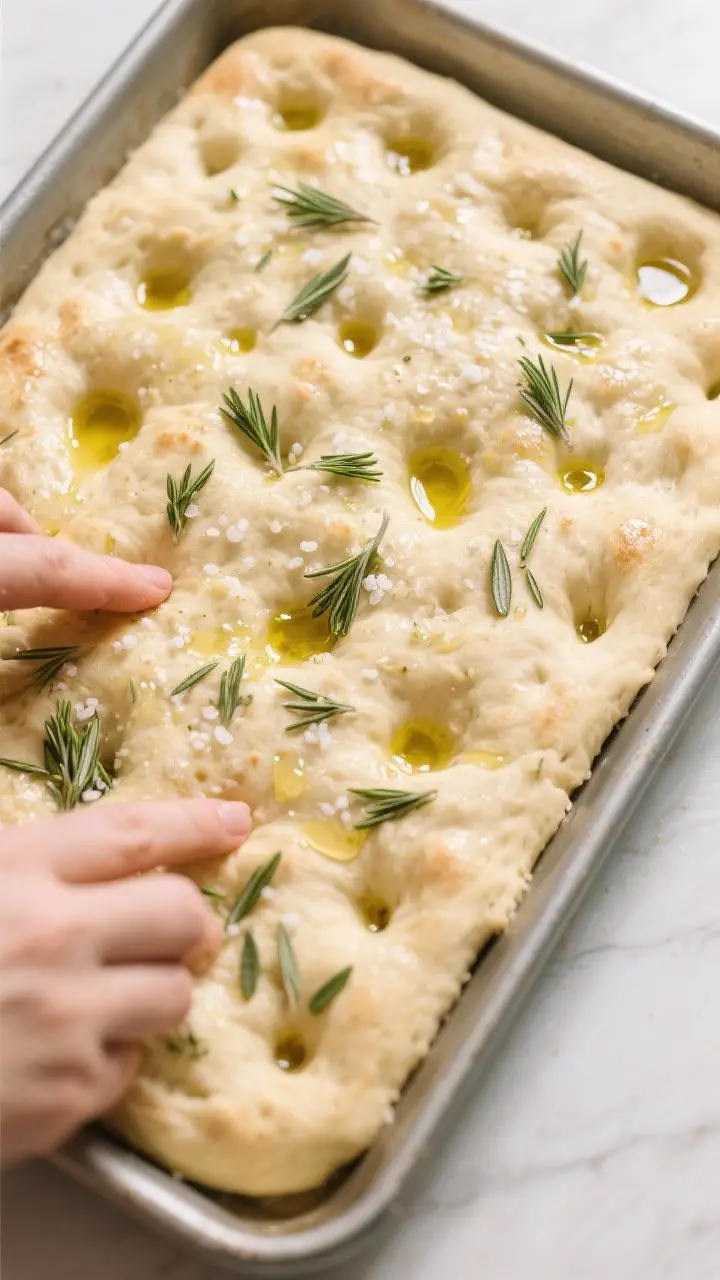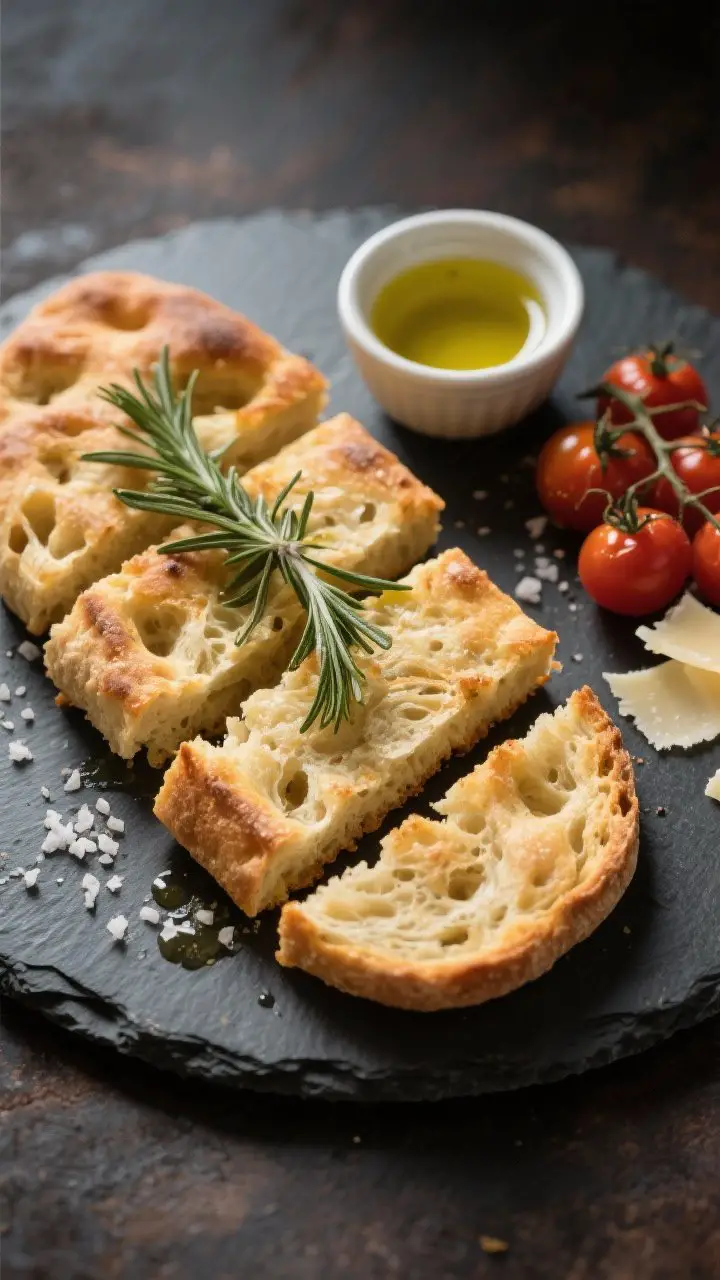Rustic Focaccia With Rosemary and Sea Salt – Simple, Flavorful, and Comforting
Warm, fragrant, and irresistibly golden, rustic focaccia is the kind of bread that makes a meal feel special with almost no effort. It’s light and airy inside, crisp at the edges, and deeply flavorful thanks to olive oil, rosemary, and flaky sea salt. You don’t need a mixer or fancy technique—just a bowl, patience, and good olive oil.
This is the bread you tear with your hands, drag through sauce, or pile with tomatoes and cheese. If you’ve ever wanted bakery-quality focaccia at home, this straightforward recipe will get you there.
What Makes This Special

- Extra olive oil for texture: Generous oil creates a crisp, golden crust while keeping the interior soft and pillowy.
- Cold ferment option: An overnight rest develops flavor and improves the crumb without extra work.
- Classic rosemary and sea salt: Fresh rosemary perfumes the bread, and flaky salt gives pops of crunch and flavor.
- Forgiving dough: High hydration and simple folds mean you don’t have to knead aggressively.
- Versatile base: Use it as a side, sandwich bread, or a canvas for toppings like olives, onions, or cherry tomatoes.
Ingredients
- 500 g (about 4 cups) bread flour or all-purpose flour
- 10 g (2 tsp) fine sea salt
- 7 g (2¼ tsp) instant yeast or active dry yeast
- 400–425 g (1¾ cups) warm water at about 100–105°F (38–41°C)
- 60 ml (1/4 cup) extra-virgin olive oil for the dough and bowl
- 2–3 tbsp extra-virgin olive oil for the pan and topping
- 2–3 tsp flaky sea salt for topping
- 2–3 tbsp fresh rosemary, chopped
- Optional: 1 tsp honey or sugar to help jumpstart yeast
Instructions

- Bloom the yeast (if using active dry): In a bowl, mix warm water with honey or sugar and sprinkle on the yeast. Let it sit 5–10 minutes until foamy.
If using instant yeast, skip this step and add yeast directly to the flour.
- Mix the dough: In a large bowl, combine flour and fine salt. Add the yeast mixture (or water if using instant yeast) and 2 tablespoons of olive oil. Stir with a spoon until a shaggy, sticky dough forms.
It should be tacky.
- Rest and fold: Cover the bowl and let the dough rest 15 minutes. With wet hands, perform 4–6 gentle stretch-and-folds around the bowl to build strength. Repeat this rest-and-fold cycle once more after another 15 minutes.
- First rise: Drizzle 1 tablespoon olive oil around the dough, turn it to coat, and cover.
Let it rise at room temperature until doubled, about 1–1.5 hours, depending on your kitchen temp.
- Optional cold ferment: For deeper flavor, refrigerate the dough in a covered bowl for 8–24 hours after the first rise. Let it come to room temperature for 45–60 minutes before shaping.
- Prepare the pan: Generously oil a rimmed baking sheet or a 9×13-inch pan with 1–2 tablespoons olive oil. More oil helps create that signature crispy bottom.
- Shape the dough: Transfer the dough to the pan.
Gently press and stretch it toward the edges, being careful not to deflate all the bubbles. If it springs back, let it rest 10 minutes and try again.
- Second rise: Cover loosely and let the dough rise until puffy and airy, 30–45 minutes. A few big bubbles should appear on the surface.
- Dimple and top: Preheat the oven to 450°F (230°C).
Lightly oil your fingertips and press deep dimples across the dough. Drizzle 1–2 tablespoons olive oil over the surface, then sprinkle evenly with rosemary and flaky sea salt.
- Bake: Bake 20–25 minutes until the focaccia is deeply golden with crispy edges. If using a very dark pan, start checking at 18 minutes.
- Finish and cool: Transfer to a rack.
For extra flavor, brush with a thin layer of olive oil while warm. Cool 10–15 minutes before slicing to keep the crumb intact.
How to Store
- Room temperature: Wrap loosely in parchment or store in a paper bag for up to 2 days. Avoid airtight containers at room temp—they can make the crust soggy.
- Reheat: Crisp slices in a 375°F (190°C) oven for 6–8 minutes or in a hot skillet with a little olive oil.
- Freeze: Slice, wrap tightly, and freeze for up to 2 months.
Reheat from frozen in a 375°F oven for 10–12 minutes.
- Avoid the fridge: Refrigeration stales bread quickly. Freeze instead if you need to store longer.

Health Benefits
- Olive oil fats: Extra-virgin olive oil provides monounsaturated fats and polyphenols, which support heart health when used in place of saturated fats.
- Whole-grain option: Swap in up to 30% whole wheat flour for added fiber and minerals without losing the tender crumb.
- Portion-friendly: Focaccia is rich, so smaller pieces satisfy. Pair with salad, grilled veggies, or lean proteins for a balanced meal.
- Low-additive bread: Homemade bread lets you control salt, oil, and toppings—no preservatives or hidden sugars.
What Not to Do
- Don’t skimp on oil: The oil prevents sticking and creates the signature crispy bottom and glossy top.
- Don’t rush the rise: Cutting rise times results in a dense, flat bread with less flavor.
- Don’t deflate the dough: Be gentle when stretching; smashing out air pockets will reduce that open crumb.
- Don’t overbake: Dark should be golden, not brown-black.
Overbaking dries the interior and toughens the crust.
- Don’t overload with toppings: Heavy, wet toppings can weigh it down and create soggy spots.
Alternatives
- Herb swaps: Try thyme, oregano, or a mix of herbs de Provence. Fresh herbs deliver the best aroma.
- Sweet onion: Thinly sliced red onion or shallots add sweetness and char. Toss lightly in oil before adding.
- Olive and tomato: Stud the dough with halved cherry tomatoes and pitted olives.
Reduce salt slightly to balance.
- Cheesy top: Sprinkle grated Parmesan or pecorino during the last 5 minutes of baking for a savory finish.
- Garlic oil: Infuse the olive oil with gently warmed smashed garlic cloves, then drizzle before baking.
- Gluten-free: Use a gluten-free bread flour blend designed for yeasted doughs and follow package hydration guidance. Expect a softer, less open crumb, but great flavor.
FAQ
Can I make this without a stand mixer?
Yes. This dough thrives with simple mixing and a couple of stretch-and-folds.
📖 Get Access to 50+ Printable Smoothie Recipes Instantly! 🖨️
Boost your health with delicious smoothies! These easy-to-follow printable recipe eBooks are perfect for detoxing, fitness goals, and tasty plant-based living. Available for instant download on Etsy! 🌿✨
Wet your hands to keep sticking to a minimum.
What if my dough is too sticky?
A sticky dough is normal and helps create an airy crumb. Lightly oil or wet your hands, and avoid adding too much extra flour, which can make the bread dense.
Can I use dried rosemary?
You can, but use less—about 1 to 1½ teaspoons—and crush it between your fingers to release flavor. Fresh rosemary gives a brighter, more aromatic result.
How do I get big air bubbles?
Use proper hydration, give the dough time to rise, avoid overhandling, and dimple gently.
The optional cold ferment also boosts bubble structure and flavor.
What pan works best?
A well-oiled metal sheet pan or 9×13-inch pan is ideal for even browning and crisp edges. Cast iron also works beautifully if well-oiled.
Can I halve or double the recipe?
Yes. Halve for an 8–9-inch round pan.
Double for a large sheet pan, but watch rise and bake times—they may shift slightly.
Why is my focaccia pale?
It may need a hotter oven or a longer bake. Also, a light hand with oil can prevent browning; a generous drizzle promotes color and crispness.
How salty should the top be?
Use enough flaky sea salt for bright pops of flavor, not a blanket. Start with about 2 teaspoons and adjust to taste.
In Conclusion
Rustic focaccia with rosemary and sea salt is simple, satisfying, and endlessly useful.
With a few pantry ingredients and good olive oil, you get a bread that’s crisp on the outside, tender inside, and full of aroma. It works for weeknights, gatherings, or as the foundation for a standout sandwich. Make it once, and it will quickly become your go-to house bread.





